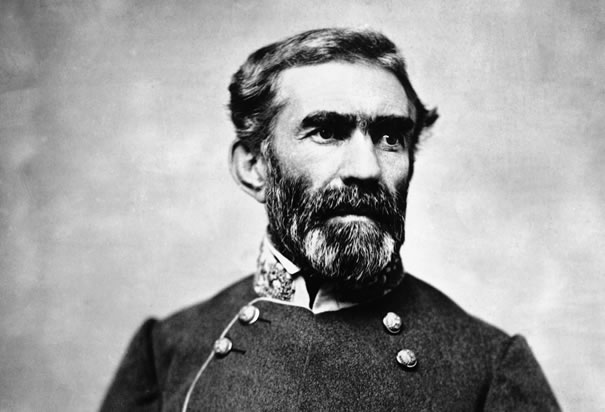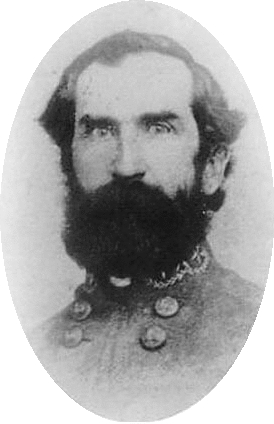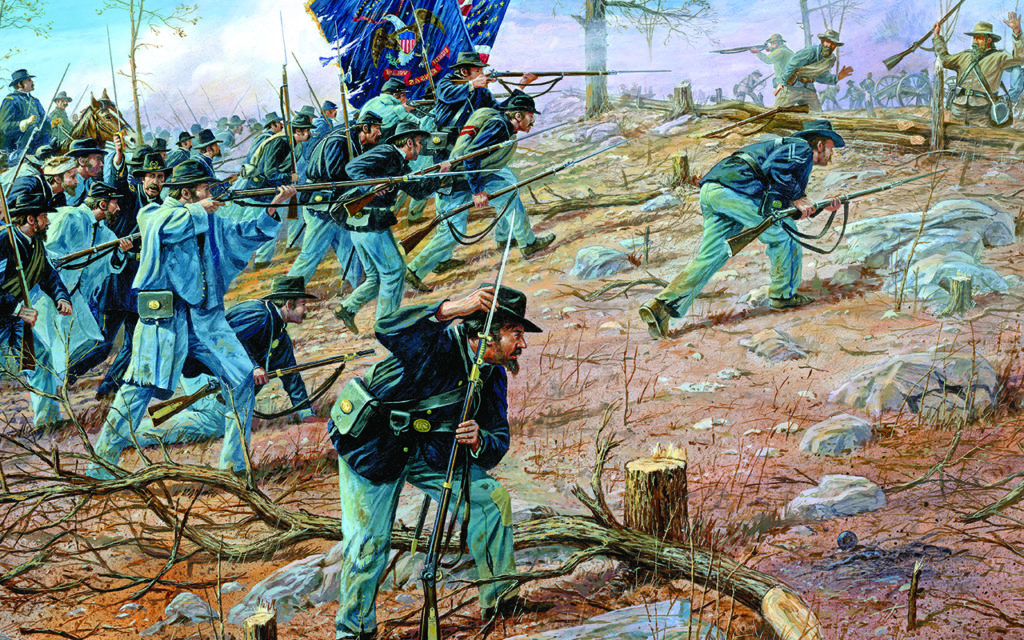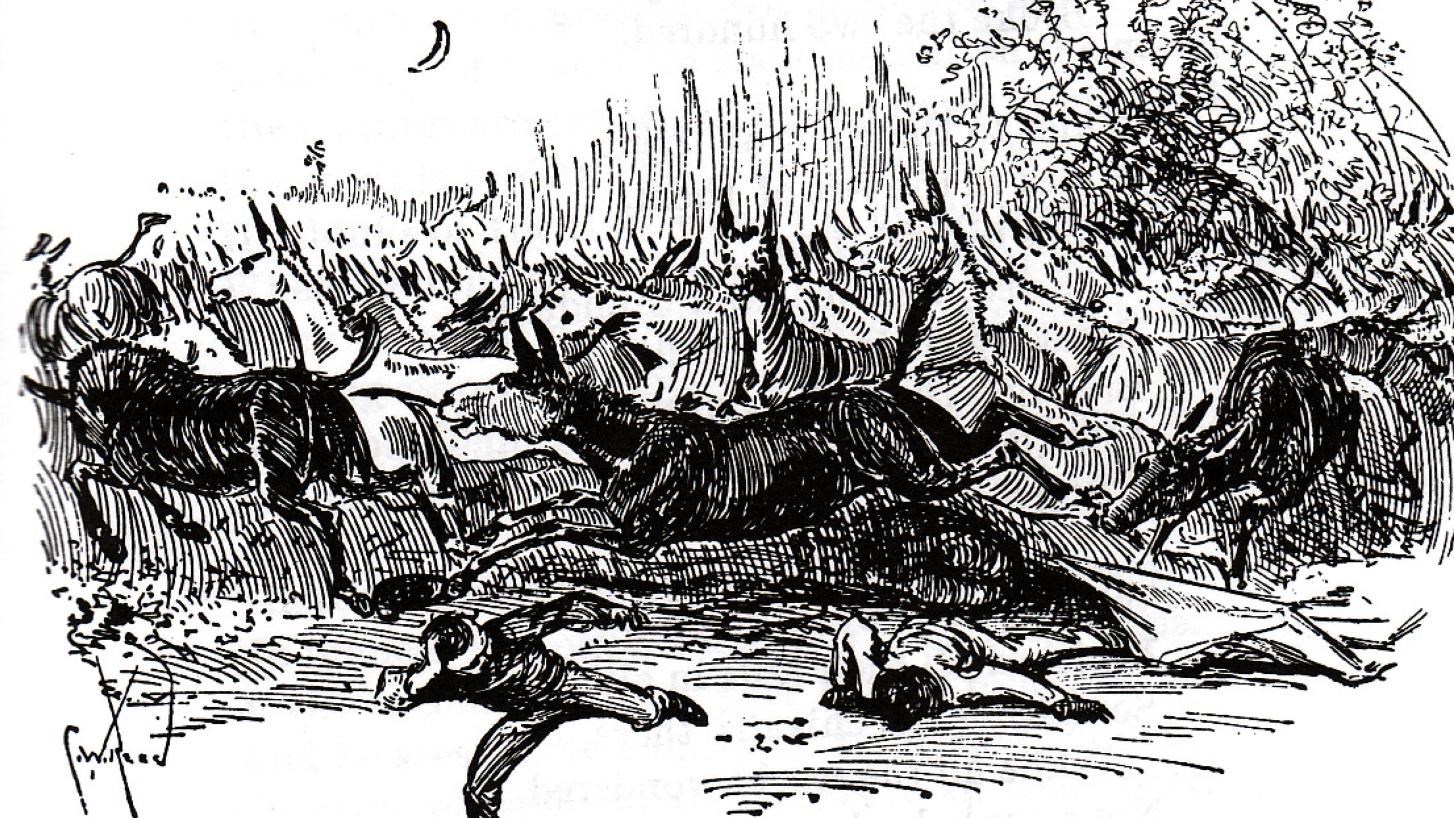My early reading about these 1863 battles included some frequently repeated myths. The Union victory at Lookout Mountain was attributed to the steep slope – so steep that guns wouldn’t bear properly on attacking troops. Likewise, the equally rugged Missionary Ridge was said to have fallen because the Confederate works were on the geographic crest, rather than the military crest, stifling the field of fire. Last, Sherman’s attack on the west end of the ridge was said to have stalled. We’ll see about these.
A trip to these
battlefields some years back made me take a fresh look. Both positions looked like they could be held by boy scouts armed with rocks. I then read two modern books
about the campaign, “The Shipwreck of Their Hopes” by Cozzens and “Mountains
Touched with Fire” by Sword. Both determined that the Confederate defeats at
Lookout Mountain and Missionary Ridge were due to serious errors by the deeply
unpopular General Braxton Bragg, compounded by the errors of some of his
subordinates.
First, we will set the stage. Having won the battle of Chickamauga at great cost, the first victory of size in his theater, Bragg took the opportunity to savage his enemies – his own generals. This allowed the Union Army of the Cumberland to recover somewhat and dig in around Chattanooga. They were still in trouble because the Confederates soon interdicted their rail and river supply lines. The Yankees were reduced to half rations while their horses and mules died from starvation. The long route over the mountains north of the city was unable to support the army. Bragg deployed on the mountains overlooking the enemy from the south, assuming he would starve them out. He began to settle feuds with his restive generals, who had asked Jefferson Davis to sack Bragg. They had previously asked this in 1862. Davis came out west to mediate. He backed Bragg, kicking the can down the road, as he often did with the western theater.
Having won
Davis’s approval, Bragg exiled his main critic, corps commander Polk. The Louisiana
general was no great military talent, but was popular among the troops. Bragg,
styling himself a sophisticate, looked down on Tennessee officers and troops he
considered ruffians. This was bad policy since the largest contingent in his
army, called the Army of Tennessee, was from that state. And they returned the
favor. He broke up Cheatham’s all-Tennessee division, angering that general and
lowering morale among the troops. Cheatham wasn’t brilliant but was a fighting
division commander when sober. (He didn’t perform well at Stones River and was
rumored to have been at the bottle that day.) Cheatham was so furious that he
took a leave, missing the battle. His division was left in the hands of his less
than heroic senior brigade CO, derisively known to his troops as Mudwall
Jackson (instead of Stonewall Jackson). This division guarded Lookout Mountain.
This will figure later in our story.
Many other
units were shifted around, ensuring that no division contained too many restive
Tennessee units. While no division remained a center of opposition, it spread
malcontents throughout the army. Bragg seems not to have considered the effect
on army morale. Bragg also had a feud going with Longstreet, whose sledgehammer
attack on the second day of Chickamauga had seized victory from the jaws of
defeat. It takes two to tango; Longstreet bears some blame for the feud, as did
so many of the general officers in that army for their feuds with Bragg and
others. Bragg decided to get Longstreet out of his hair by sending him and his
two veteran divisions from the Army of Northern Virginia off to besiege
Knoxville. This weakened his infantry by nearly a third. Meanwhile the looming
disaster saw Grant, fresh from his triumph at Vicksburg, promoted to overall command
of the west. He was calling in reinforcements from the western Army of the
Tennessee and the eastern Army of the Potomac (northern armies being named for
rivers, southern armies named for regions). Longstreet’s departure assured
Grant an even larger numerical advantage. Also sent off with Longstreet was the
major who was the chief engineer officer of Bragg’s army. This affects our
story later.
Bragg was in
position for nearly two months before Grant began his counter-offensive. In
addition to putting his army into a state of uneasy change, he assumed that the
enemy would not attack his lines. He dug in his infantry at the base of
Missionary Ridge with artillery on top.
The Knoxville
expedition put pressure on Grant, since Lincoln feared Burnside would lose the
city, turning over the loyal East Tennesseans to the vengeful Confederates.
Grant also had problems getting his troops set for the offensive due to muddy
roads. Once things were ready, he ordered Thomas and the Army of the Cumberland
to storm the outpost of Orchard Knob before Bragg’s center. Thomas did it with
ease and style, stunning Bragg. Realizing he faced an attack out of
Chattanooga, Bragg now had his remaining engineer officer, a captain, to select
positions for fortifications along the top of the ridge. With very little time,
the captain laid out a line along the highest ground, the geographical crest.
Finding the line with the best fields of fire, the military crest, would
require more time than was available. Bragg hadn’t thought to have this done
during the preceding two months. He’d been too busy with his vendetta against
the internal critics in his own army. But it would take yet another error to
lose the ridge.
First, we
return to Lookout Mountain. Cheatham was away. Mudwall Jackson was in charge, opposed
by Joe Hooker. Hooker had genuine skill, marred by his getting flustered at times
(like Chancellorsville) and his self-promotion. He figured that the Confederate
left must only go so far on Lookout Mountain and guessed right when he picked a
spot beyond it. His 3,500+ soldiers advanced towards the imposing mountain, fearing
a trap. Their mood changed to exaltation as they reached almost to the summit
without a shot fired and faced left, advancing along the slope. They struck the
single Rebel brigade in the flank, as other Union troops probed the Rebel
front. The Confederates collapsed and fled around the northern edge of the
mountain. The few troops on the summit could only get shots at the Yankees
below by exposing themselves to return fire. They made little impact on the
cheering bluecoats. Mudwall stayed back, well out of the line of fire. He finally
sent one of his 3 other brigades to face the Yankee attack. This brigade
stopped the victorious Yankees, who were disordered by their rapid advance.
Elements of a third brigade joined the fight on their own, without orders. Hooker now became flustered and called for help, fearing a
counterattack. But no other Rebels appeared and in time the outnumbered Confederates
fell back, low on ammo. When the mist cleared, the sight of Old Glory on the
mountain brought wild cheers from the assembled Yankees below and gloom to the
Rebel troops. It was more important as a morale event than anything else. The
battle was lost because Hooker out-thought and outfought Mudwall Jackson. It is
hard to imagine that Frank Cheatham wouldn’t have put up a sterner fight.
The next day, Sherman was tasked with smashing the Confederate right flank while Thomas’ troops in the center looked on. His attack came to grief; more on that later. Grant thought reinforcements were being sent against Sherman and ordered Thomas to storm the works at the foot of Missionary Ridge to fix the Rebels’ attention. Along with the hastily sited works atop the ridge, there was a critical flaw in the Confederate defense plan. Sources vary on which corps commander was responsible for the order, Hardee or Breckinridge. In any case Bragg should have been overseeing matters. Half of the troops were deployed in the works at the base of the ridge and the other half in the poorly sited works on top. The troops at the foot of the ridge were told to make a brief fight and then fall back up the ridge to join the troops at the summit. This order was poorly relayed; some troops weren’t aware of it. When over 20,000 Union troops moved forward, all could see this massive attack, while many on the ridge could only see a few hundred friends to either side. Firing broke out and then many of the troops at the base took to their heels, spooking the ones who didn’t know of the order. Flanks exposed, these soon fell back too and the whole bunch began climbing the ridge. The Yankees who had stormed the works at the foot realized they were exposed to fire from the crest. These soldiers from the Army of the Cumberland had been on short rations for two months and been taking abuse from Hooker’s and Sherman’s reinforcements about having run at Chickamauga. Seeing the backs of their enemies, they started up the ridge without orders, chasing the retreating Rebels. A long, steep climb while being shot at by a swarm of pursuers took the starch out of those Rebels. They reached the top exhausted and in a state of panic. They ran right through the upper line and kept going, shaking the morale of the troops on top. With that, half of the defenders were out of the fight. Union troops swarmed after them, aided in places by dead ground in front of the works where they could catch their breath without being shot at before making a final rush. In other places the field of fire was open and Yankees there took heavy losses. One such regiment saw young Arthur MacArthur (who would sire Douglas) win the Medal of Honor leading his men while bearing the regimental colors. The whole Rebel line collapsed, yielding many prisoners and guns. The poorly sited line was indeed part of the reason the ridge fell. But the ill-conceived decision to split the troops between ridge top and base with the lower troops giving way immediately was certainly more important. And then there’s Bragg’s war on the morale of his army.
On to the final myth, that Sherman’s attack was held up. Sherman had dawdled away the morning waiting for Howard’s two eastern divisions to come up. With at least five divisions, he launched a piecemeal attack with elements of two divisions against the north end of Missionary Ridge. Sherman was not a great battlefield commander. His skills lay more in the moves before and after battles, the sort of thing our tactical games don’t account for. This was one of his worst performances. His 9 year old son Willie had recently died of fever caught in an army camp. Some histories maintain Sherman didn’t buckle under the grief. I think this day’s fighting says otherwise. He also was facing Patrick Cleburne’s division. The Irish immigrant was undoubtedly the best division commander in Bragg’s army. He had just taken up position and hadn’t had time to follow the botched plan. He likely would have ignored it. All his troops were atop the ridge, poorly sited works or not. The troops from the Union Army of the Tennessee, used to victory, came on strong and a desperate fight ensued. At the critical moment Cleburne ordered a bayonet charge by several regiments and the Union line collapsed, routing down the ridge and losing hundreds of prisoners. Some of the rout could be seen from Grant’s headquarters. The order for Thomas to advance came soon afterwards. It should be noted that Cleburne’s earthworks weren’t better sited than the rest on the ridge, just much more competently defended.
Years later
someone asked Grant about his troops attacking what seemed to be impregnable
defenses. Grant smiled and said, “Well, they were”.
Three myths,
each with some kernel of truth.
Troops on the
summit of Lookout Mountain didn’t have a good field of fire down the steep
slopes. The inept deployment of one brigade of the four available to Mudwall, with
a single brigade sent to help after the first was routed combined with Hooker’s
flash of inspiration flanking that lone brigade were much more important.
The poor, hasty
siting of the Confederate line atop Missionary Ridge (after two months in
residence) was less a factor than the bungled defense plan. Throw in the monkey
wrench to his army’s morale of Bragg’s vindictive reorganization.
Sherman’s
attack wasn’t “held”, it was whipped. By troops fighting from the same hasty,
poorly sited works, against an attack that used less than a third of the troops
Sherman had available, on a position he could have flanked.
And those are
three myths about the Chattanooga battles. A very pretty town. We had some excellent barbeque at Shuford’s Smokehouse, north of the town.
PS: an amusing minor myth: in the days before Grant’s offensive, Hooker’s easterners marched north up a road on the western flank of Lookout Mountain after other troops reestablished the river supply line. Bragg ordered Longstreet to make a nighttime attack on Hooker. As often happens in night battles, confusion reigned and little was accomplished aside from more dead and wounded soldiers. In the aftermath of the battles, a rumor made the rounds of the Union armies. A herd of army mules was said to have stampeded into Confederate troops who broke and ran, thinking it was a cavalry charge. This amusing tale has no basis in fact but went viral, over a century before the internet. One anonymous wag penned a ditty modeled after Tennyson’s “Charge of the Light Brigade”.
The Charge of the Mule Brigade
Half a mile,
half a mile,
Half a mile
onward,
Right through
the Georgia troops
Broke the two
hundred.
'Forward the
Mule Brigade!
Charge for the
Rebs,' they neighed.
Straight for
the Georgia troops
Broke the two
hundred.
Many more such
stanzas before it ended with:
When can their
glory fade?
Oh, what a wild
charge they made!
All the world
wondered.
Honor the
charge they made!
Honor the Mule
Brigade,
Long-eared two
hundred!
Fake history, great doggerel.












